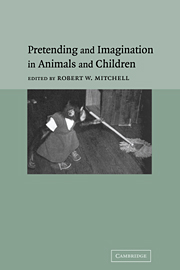Book contents
- Frontmatter
- Contents
- List of contributors
- Foreword by Sue Taylor Parker
- Preface and acknowledgments
- I Historical, developmental, and comparative overviews
- II Pretense and imagination in children
- III Pretense and imagination in primates
- 13 Pretending in monkeys
- 14 Pretending primates: play and simulation in the evolution of primate societies
- 15 Representational capacities for pretense with scale models and photographs in chimpanzees (Pan troglodytes)
- 16 Pretending in free-ranging rehabilitant orangutans
- 17 Seeing with the mind's eye: eye-covering play in orangutans and Japanese macaques
- 18 Possible precursors of pretend play in nonpretend actions of captive gorillas (Gorilla gorilla)
- 19 Pretending culture: social and cognitive features of pretense in apes and humans
- 20 Empathy in a bonobo
- 21 Pretend play in a signing gorilla
- IV Prospects
- References
- Author Index
- Subject Index
15 - Representational capacities for pretense with scale models and photographs in chimpanzees (Pan troglodytes)
Published online by Cambridge University Press: 13 August 2009
- Frontmatter
- Contents
- List of contributors
- Foreword by Sue Taylor Parker
- Preface and acknowledgments
- I Historical, developmental, and comparative overviews
- II Pretense and imagination in children
- III Pretense and imagination in primates
- 13 Pretending in monkeys
- 14 Pretending primates: play and simulation in the evolution of primate societies
- 15 Representational capacities for pretense with scale models and photographs in chimpanzees (Pan troglodytes)
- 16 Pretending in free-ranging rehabilitant orangutans
- 17 Seeing with the mind's eye: eye-covering play in orangutans and Japanese macaques
- 18 Possible precursors of pretend play in nonpretend actions of captive gorillas (Gorilla gorilla)
- 19 Pretending culture: social and cognitive features of pretense in apes and humans
- 20 Empathy in a bonobo
- 21 Pretend play in a signing gorilla
- IV Prospects
- References
- Author Index
- Subject Index
Summary
Examining symbolic, pretend play in a nonverbal individual, especially one who is not human, is inevitably fraught with difficulties in identification and interpretation. For example, a young wild chimpanzee maneuvered a small stick in a manner similar to the ant-fishing technique seen in older individuals, but there were no ants present. Goodall (1986) interpreted this action as possible evidence that the chimpanzee was imagining or pretending that there were ants present, although other interpretations are possible. Call & Tomasello (1996; Tomasello & Call, 1997), by contrast, suggest that such behavior may be more parsimoniously explained as simple manipulative play with sticks, and thus attribution of mental imagery and pretense is not necessary in the interpretation.
Still, there are accounts of captive members of all four great ape species producing pretend play. For example, they have been observed participating in pretend play with dolls, engaging in behaviors such as tickling and feeding (Hayes, 1951; Gardner & Gardner, 1978; Tomasello & Call, 1997). Controversy remains as to whether these behaviors truly constitute symbolic play. Arguments against the existence of symbolic object play in the great apes have been supported by a study conducted by Premack & Premack (1983) which suggested that young chimpanzees were unable to recognize the correspondence between a pretend room and its real-world referent (Call & Tomasello, 1996; Tomasello & Call, 1997). Chimpanzees watched as a small object was hidden within a model of a room.
- Type
- Chapter
- Information
- Pretending and Imagination in Animals and Children , pp. 210 - 228Publisher: Cambridge University PressPrint publication year: 2002
- 1
- Cited by



